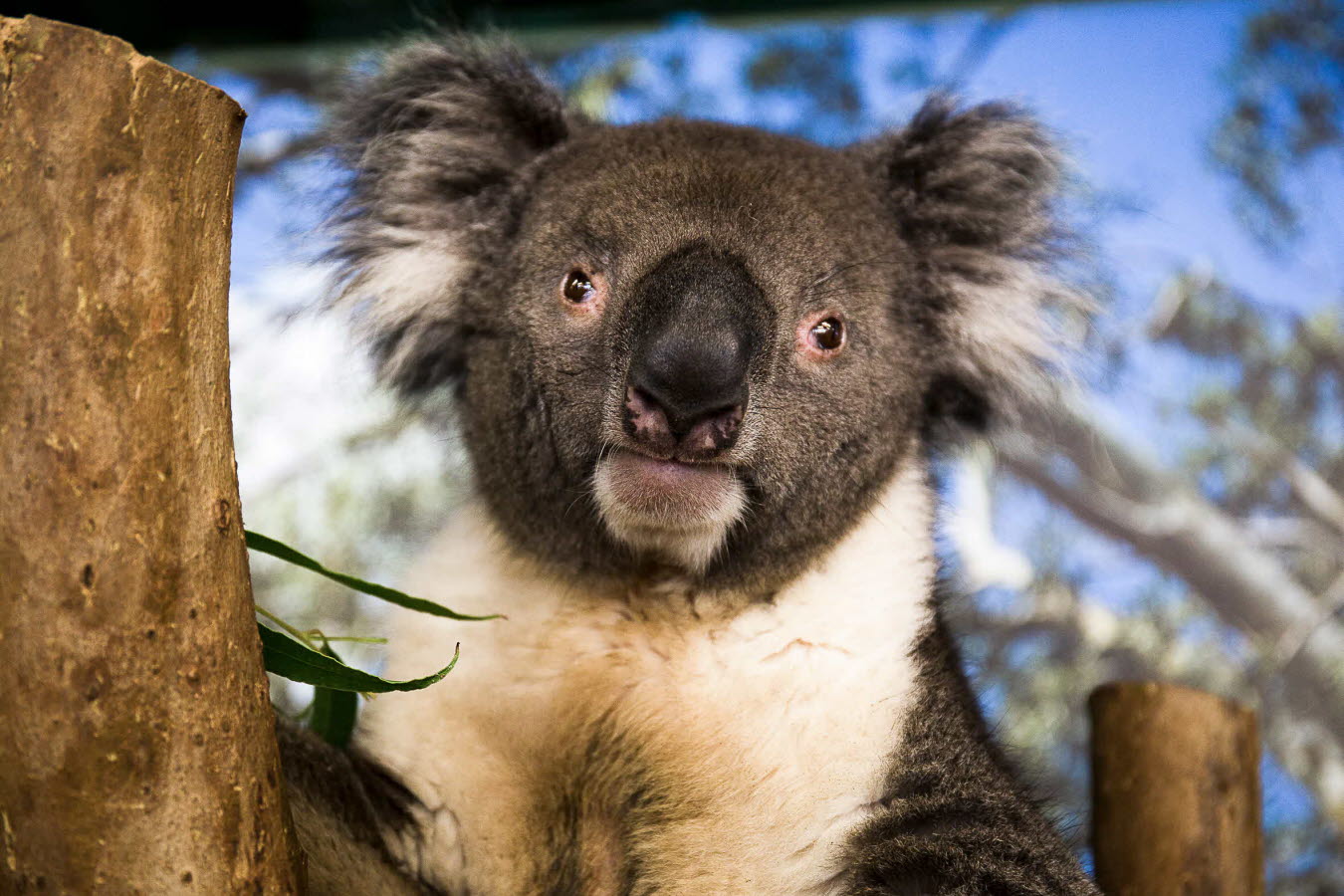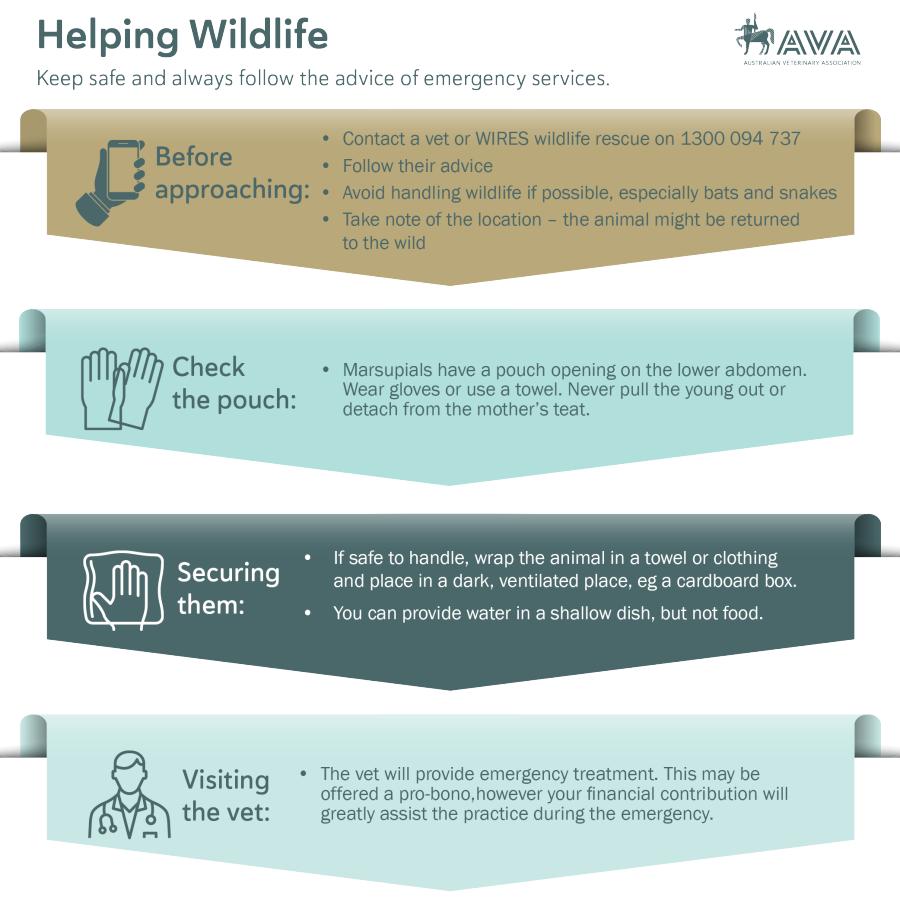
More information on helping animals in a natural disaster can be found here.
Australia hosts a diverse range of unique wildlife species and is home to most of the worlds’ marsupial species, including kangaroos, wallabies, possums, koalas, wombats, and Tasmanian devils. Marsupials are particularly distinctive in that they give birth to underdeveloped young and nurture them in an abdominal pouch.
When these young are born, they are hairless and blind and remain completely dependent on their mothers for survival. Additionally, a variety of reptile and bird species are also native to Australia. Due to increased urbanisation, road traffic accidents and habitat disruption, native species are commonly encountered and assisting them to get the help and treatment they need is important.
How to help injured wildlife
Wildlife species require special care and it is illegal to keep native animals at home. Veterinarians and licenced wildlife rescue organisations are qualified to care for and rehabilitate native wildlife. Wild animals, particularly if injured, can behave very aggressively and cause harm to people trying to help them thus approaching or picking up wildlife is not advisable. Contacting a dedicated native wildlife rescue organisation such as WIRES (NSW) would be the most appropriate course of action. They can advise you over the phone what to do whilst keeping you safe and preventing further harm, injury or stress to you and to the animal. WIRES and similar organisations in other states have a widespread network of volunteers throughout each state who are trained to triage,correctly handle and assist in the collection of injured wildlife and will bring them to a veterinarian for treatment before animals may be placed in care for rehabilitation back into the wild.
Call a local vet hospital or call WIRES:
- State your specific location
- Remove any risks or threats to the situation such as dogs or children
- Explain any visible injuries that you can see on the animal without touching it
What should I do if I find an injured bird?
If you find an injured raptor or bird of prey, keep your distance and do not attempt to contain it. If you find a bird with little to no feathers and its eyes are closed, it is in immediate danger. Please gently place in a towel, keep it warm and transport it to your nearest vet hospital for immediate treatment.
If you must handle a bird, do so with great care. Birds cannot tolerate compression on their chest and this could cause them to suffocate. Use gloves. Use a towel to gently cover the bird entirely, including its head.
Try to ensure wings are placed in their normal position as not to cause any damage or further injury to them. You can now pick it up, being careful not to grasp too firmly, and place into a cardboard box or alike, ensuring holes are made for appropriate ventilation. Please do not feed without veterinary or wildlife rescue advice.
What should I do if I find an injured bat?
Never touch a bat with your bare hands. If you find an injured bat, refrain from handling it and contact WIRES or a licensed wildlife organisation in your state. Often bats may look like they are injured but are often simply asleep.
Wait until the evening to see if it leaves of its own accord. If you find a bat lying on the ground, use a towel to scoop it into a cardboard box or carrier with appropriate ventilation and place it away from stressors such as dogs, cats or children.
If the animal is in need of urgent assistance and you are unable to contact a wildlife rescue organisation, protect yourself by wearing thick gardening gloves, a jacket and any other personal protection that you may have access to. Avoiding being licked, scratched or bitten is vital for your protection as bats and other wildlife species may carry diseases transmissible to humans. Approach the animal from behind, drop a towel over entire animal including the head and quickly place the bat into an appropriate box or container. Contact a local wildlife organisation or vet hospital for further assistance. During transport, to minimise stress to the animal, please keep noise to a minimum – keep the radio off.
What should I do if I find an injured reptile?
Blue tongue lizards, water dragons and turtles are known to frequent suburban gardens and poolside areas. Though these species are generally elusive and not particularly aggressive in nature, they can be, under due stress if injured or unwell.
Always take care when approaching reptiles. If you encounter an injured lizard, use gloves and a towel to place into an appropriate box or carrier with ventilation. Skinks can drop their tails under stress, so do not handle them by their tails. Dragons are larger and may be handled with one hand supporting its underbelly and the other holding its tail. Keep hands well away from the mouth as they will bite. They will also use their tail to whip if it is not restrained. Freshwater turtles are easy to handle but may bite so be virulent of their head placement.
Position their rear away from you as some species may spray an odour under threat. Place one hand on either side of the top shell between the front and back legs and gently place into an appropriate carrier.
But what about snakes?
Do not attempt to handle an injured snake and keep your distance. Unlike the aforementioned reptile species, snakes are much more difficult to handle and it is recommended that appropriately trained handlers are contacted to identify and retrieve snakes.
Please keep an eye on the snake from a safe distance and quickly contact WIRES who will dispatch an experienced snake rescuer to attend to the animal accordingly. Do not approach the snake or try to contain it yourself. If found in the home, remove threats, secure the room by closing doors and placing towels along gaps under the door.
If you find a snake in your garden with no obvious injuries, monitor from a safe distance and wait for a few hours as often they will just be moving through the garden. If injured, follow the steps above.
What should I do if I find an injured Kangaroo, Possum, Koala or Wombat?
It is unlikely to see each of these species in the daytime, as they are nocturnal. If you find an injured macropod (kangaroo or wallaby) please do not approach it, remove any threats and contact a rescuer or local police to attend, if out of hours. Due to their sheer size, they require safe handling by specialised wildlife carers.
If you find an adult koala, wombat or possum, it is not advisable to approach them yourself. Contact a wildlife carer to assist you. If you find an orphaned or injured joey, you can use a towel to safely contain the animal and place it in a quiet, dark, warm place ideally wrapped in the towel and placed into an appropriately ventilated carrier or box. Warmth is particularly important for joeys as they are particular vulnerable at a younger age.
Always check the pouch
Particularly in the context of animals that have been hit by cars, always check the pouch. Pay particular attention to possums as the smaller of the two common species, the Ringtail possum, may often carry twins or even triplets.
Also, check the surrounding area in case a joey has fallen out of the pouch on impact. Most marsupials have a pouch opening on the lower side of the abdomen. Wombat pouches are positioned slightly lower down and open from the other direction. Wear gloves and have a towel ready upon locating and opening the pouch to prevent a joey from escaping.
Lift the skin to stretch open the pouch, use a light to see into the pouch. Newborn joeys can be tiny and difficult to see. The mouths of young hairless joeys are fused to the mothers’ teat. Do not remove the teat from the joey’s mouth as this can cause serious injury to the joey. If possible, leave the joey attached and within the pouch of the deceased mother to transport to the nearest vet. Check the mother is dead and if you are unable to take the mother, cut the mother’s teat as close to the body as possible to leave the teat securely attached to the joey’s mouth.
Furred joeys can be gently encouraged out of the pouch. Never pull them out. They may be wrapped in a towel, preferably something softer. A makeshift pouch is desirable, which wildlife carers will have to hand.
Transport the joey as quickly as possible to the nearest vet hospital or wildlife carer. Do not feed the joey, as specific nutritional supplementation is required for joeys. The incorrect formulation of food will be harmful to them at this young age.
Please contact WIRES on 1300 094 737.

